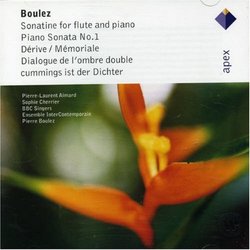| All Artists: Boulez, Ensemble InterContemporain Title: Boulez: Sonatine / Pno Sonata No 1 / Derive Members Wishing: 0 Total Copies: 0 Label: Wea Apex Classics UK Original Release Date: 1/1/2006 Re-Release Date: 4/14/2006 Album Type: Import Genre: Classical Style: Number of Discs: 1 SwapaCD Credits: 1 UPCs: 0809274998729, 809274998729 |
Search - Boulez, Ensemble InterContemporain :: Boulez: Sonatine / Pno Sonata No 1 / Derive
 | Boulez, Ensemble InterContemporain Boulez: Sonatine / Pno Sonata No 1 / Derive Genre: Classical
|
Larger Image |
CD Details |
CD ReviewsA highly varied collection of "minor" pieces Christopher Culver | 08/05/2006 (5 out of 5 stars) "This entry in Warner Classics' budget Apex line, a reissue of a disc originally released on Erato in 1991, contains six generally minor works by Pierre Boulez. The collection reminds me vaguely of the concept of "b-sides" in rock music, and just as with many rock acts, one feels that some gems are unfairly neglected. The Ensemble Intercontemporain and BBC Singers perform, conducted by the composer himself. The pieces were recorded in the projection space at IRCAM, and so the sound quality is very good indeed.
Two of the pieces here are among Boulez's earliest acknowledged works. The "Sonatine" for flute and piano and the "Piano Sonata No. 1" both date from 1946, when Boulez was still trying to find his own sound going beyond the basis he found in the Second Viennese School. The "Sonatine" is inspired by Schoenberg's "Chamber Symphony op. 9" in form and by Berg in its serial material, while both the "Sonatine" and the Piano Sonata find inspiration in Webern and Schoenberg for the virtuoso and "delirious" piano parts. The "Sonatine" is a rather unexciting work, I'd call it juvenalia even if Boulez thinks it worthy of preservation. However, the Piano Sonata No. 1 is a rich piece which displays new sides of itself on every listen. I quite enjoy Pierre-Laurent Aimard's performance here, it has a savagery to it unlike the methodical touch of Jumppanen or the nimbleness of Biret. The collection jumps over 20 years to "cummings ist der Dichter" for mixed choir and orchestra (1970), a setting of a e.e. cumming's poem. It preserves something of the interest in open or aleatoric forms that preoccupied Boulez through the "Piano Sonata No. 3", the first versions of "Pli selon pli", and "Eclat" in that the choral conductor still has some autonomy, but the instrumental conductor clearly retains overall control. "cummings ist der Dichter" piece introduces listeners of this collection to the recent Boulez, where the functional bleep-bloops of the early works have been replaced with glittering colours, a general turn from pointillism to working with blocks of sound. And instead of the sluggish tempos and excessive silences of some 1950s pieces we hear a frenetic alternation of screaming highs and awesome lows. It's a pity that this piece isn't better known, I find Boulez's use of a choir makes for great listening. The strengths of the recent Boulez continue in "Derive" for small ensemble (1984). Scored for flute, A clarinet, violin, cello, vibrophone, and piano, the piece "derives" its harmonies from a six-note chord E-flat, A, C, B, E, and D, which in a mixed French-German-English nomenclature represents the name of Swiss music patron Paul Sacher. The same basis is used in "Eclat" and in "Messagesquisse", and in all the results are quite different. Here, "Derive" reminds one of the work of Magnus Lindberg, obsessed with the constant production of gorgeous harmonies and only occasionally letting melody creep in. The piece was recently re-recorded on Deutsche Grammophon in the "20/21" series with the same ensemble and conductor, and even venue. While the quality of the performances is even, I think the new recording on DG is much more "alive" than here. "Memoriale" for flute and eight instruments (1985) is subtitled "...explosante-fixe... Originel", because it comes from the last section of that grand work for two flutes, MIDI flute, ensemble, and electronics where the instruments pass through several "transitoires" before reaching this soft, meditative end. This sequence liberated from "...explosante-fixe..." was written in memory of Ensemble Intercontemporain flautist Lawrence Beauregard, just as the large work was written after the death of Stravinsky. Again, it shows Boulez's superb ability to pair highly-active sections with slower and smooth but equally engaging passages. If you've got ahold of the Deutsche Grammaphon disc in the "20/21" series with "...explosante-fixe...", and I highly recommend that piece, then this Apex disc is especially worth getting because "Memoriale" allows one of the examine an important part of the larger piece on its own. "Dialogue de l'ombre double" for clarinet and electronics (1982-85) was expanded from a fragment of the revised version of "Domaines" (first written in 1969). The electronics do not alter the soloists' sound, but rather they exist only to play a pre-recorded clarinet track. The soloist can select among the six section as he desires, providing an open form much like the "Piano Sonata No. 3" and other works. I'm not too impressed by the piece, it seems rather meandering, though it probably works better live where the special use of lighting provides drama. There's a recording on DG in the "20/21" series, where Alain Damiens performs again as here, but the difference between this performance and the later one on DG seems to be that IRCAM's Spatialisateur software, which simulates the effect of spatially separated sound sources on a mere stereo system, was not applied on this recording, while it was on the DG. If you've never heard Boulez before, I can only recommend starting with "Sur Incises", "...explosante-fixe...", and "Repons", all available in excellent performances on DG. These works here are minor in that they are less grand in their proportions, and should be encountered later, but they are generally not minor in quality. I heartily recommend this to the Boulez fan." |

 Track Listings (6) - Disc #1
Track Listings (6) - Disc #1